sample.docx 內容:

將附檔名改為.zip後
document.xml內容:
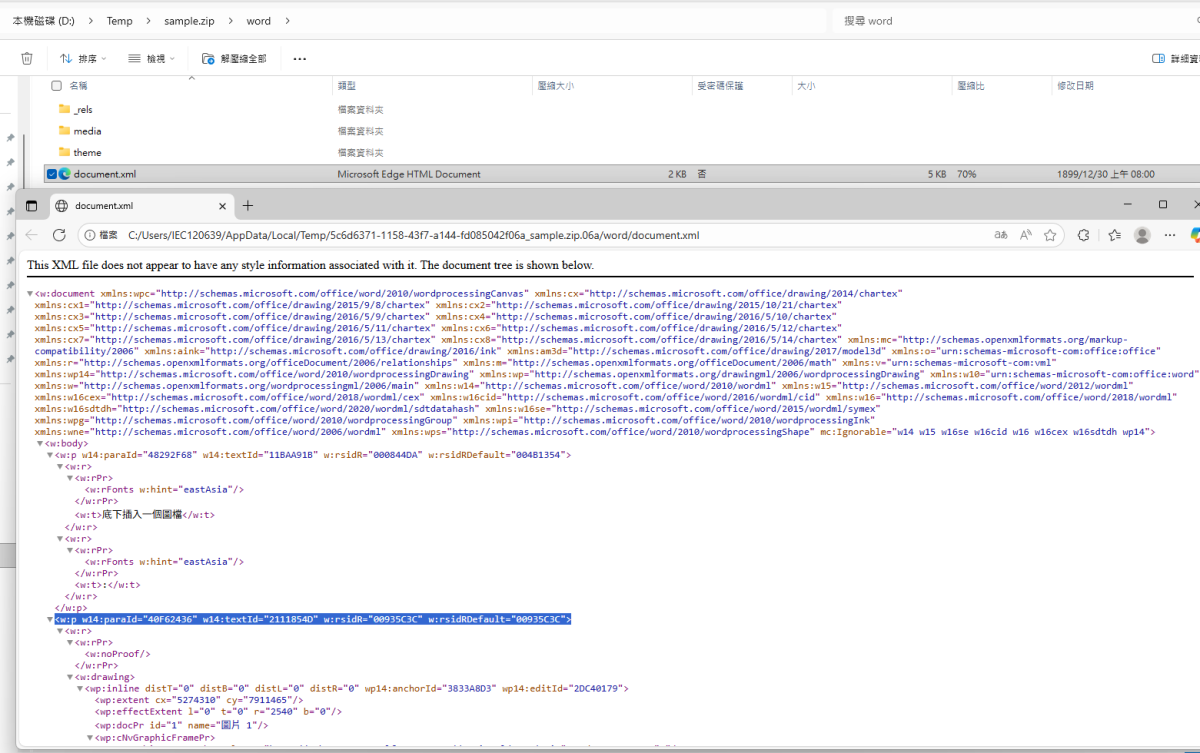
第二段w:p內容:

概要
- 以路徑 D:\Temp\sample.zip\word\document.xml 為例
- 教你用 lxml.etree 完成:讀取、XPath 查找、修改、刪除與回寫 zip/docx
- 每個段落都附上可直接在 Jupyter 執行的程式碼區塊
準備
- 檔案結構:D:\Temp\sample.zip 內的 word/document.xml
- 若你的來源是 .docx,將 zip_path 改成 .docx 亦可(.docx 本質是 OpenXML 壓縮包)
一、安裝與基本讀取
# 如果未安裝 lxml,先執行這行(在 Jupyter 內可直接跑)
# %pip install lxml
from pathlib import Path
import zipfile
from lxml import etree
# 指定你的路徑
zip_path = Path(r"D:\Temp\sample.zip")
member = "word/document.xml"
# 讀出 XML 字串
with zipfile.ZipFile(zip_path, "r") as zf:
xml = zf.read(member).decode("utf-8", errors="replace")
# 解析
parser = etree.XMLParser(remove_blank_text=False, recover=True, huge_tree=True)
root = etree.fromstring(xml.encode("utf-8"), parser=parser)
# 常用命名空間(OOXML)
ns = {
"w": "http://schemas.openxmlformats.org/wordprocessingml/2006/main",
"a": "http://schemas.openxmlformats.org/drawingml/2006/main",
"r": "http://schemas.openxmlformats.org/officeDocument/2006/relationships",
"wp": "http://schemas.openxmlformats.org/drawingml/2006/wordprocessingDrawing",
"pic": "http://schemas.openxmlformats.org/drawingml/2006/picture",
"w14": "http://schemas.microsoft.com/office/word/2010/wordml",
}
# 預覽文件有多少段落
paras = root.xpath(".//w:p", namespaces=ns)
print("段落數:", len(paras))
# 印出第一段(若存在)
if paras:
print(etree.tostring(paras[0], encoding="unicode", pretty_print=True))輸出:
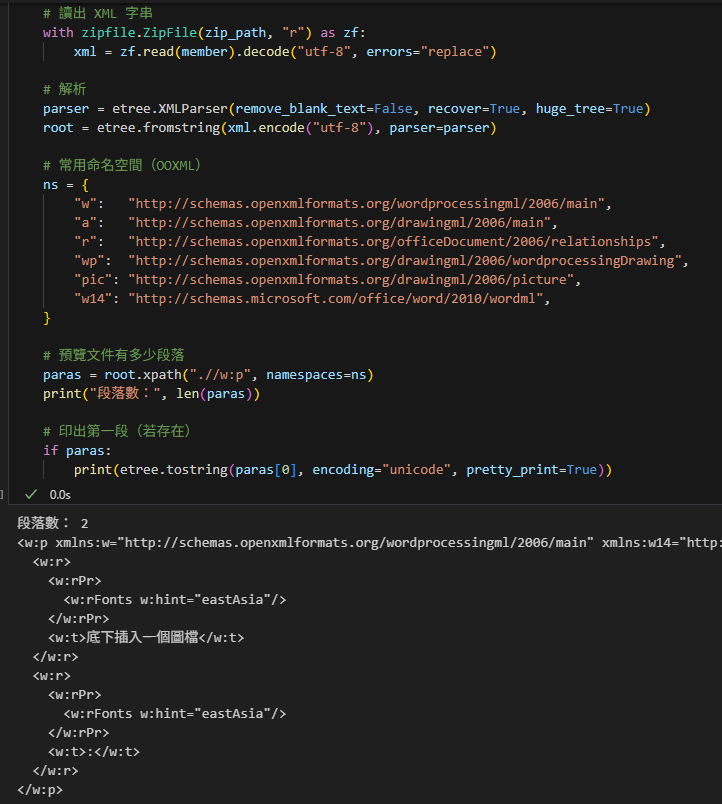
parser :
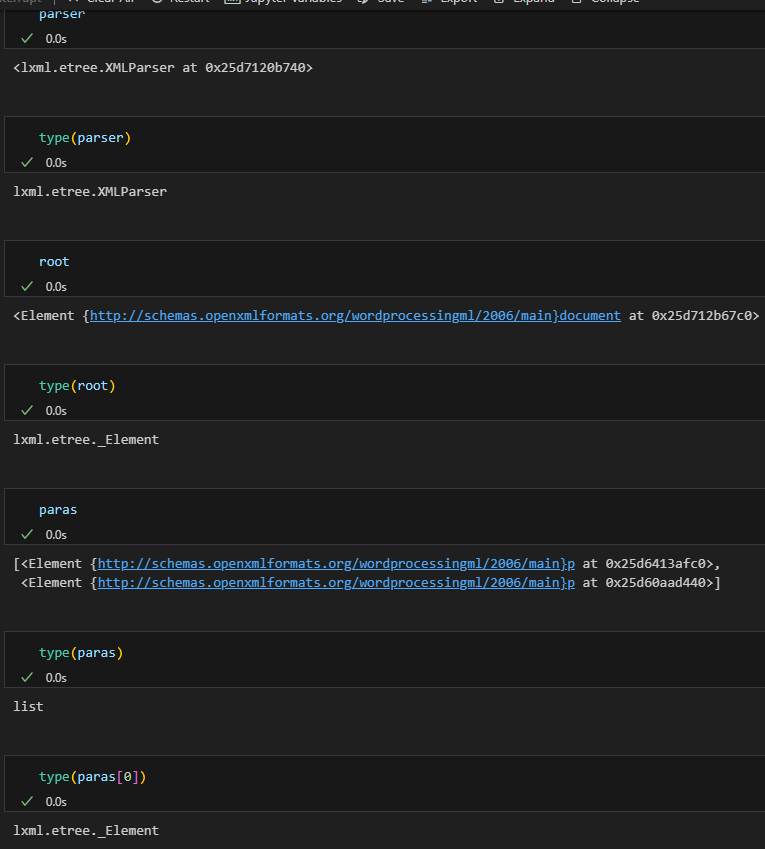
二、用 XPath 精準查找:找出含特定圖片 rId 的段落
# 想查找的關聯 ID(例如 rId4)
rid = "rId4"
# 1) 查找外層段落 w:p,條件:內部有 a:blip 的 r:embed 或 r:link 命中
xp = ".//w:p[.//a:blip[@r:embed=$rid or @r:link=$rid]]"
hits = root.xpath(xp, namespaces=ns, rid=rid)
print("命中段落數:", len(hits))
# 2) 顯示第一個命中的 paraId 與完整 XML
if hits:
p = hits[0]
paraId = p.get(f"{{{ns['w14']}}}paraId")
print("命中 paraId:", paraId)
print(etree.tostring(p, encoding="unicode", pretty_print=True))
# 3) 也可以直接列出文檔內所有圖片 rId
rids = root.xpath("//a:blip/@r:embed | //a:blip/@r:link", namespaces=ns)
print("文檔中出現的 rId 一覽:", sorted(set(rids)))輸出:

三、只刪除圖片,保留段落與文字
# 從文檔中移除特定 rId 對應的圖片(刪最接近的 wp:inline 或 w:drawing)
removed = 0
for blip in root.xpath(".//a:blip[@r:embed=$rid or @r:link=$rid]", namespaces=ns, rid=rid):
node = blip
# 往上走,找到可整塊移除的容器
while node is not None and node.tag not in {f"{{{ns['wp']}}}inline", f"{{{ns['w']}}}drawing"}:
node = node.getparent()
if node is not None and node.getparent() is not None:
node.getparent().remove(node)
removed += 1
print("已移除圖片數:", removed)輸出:
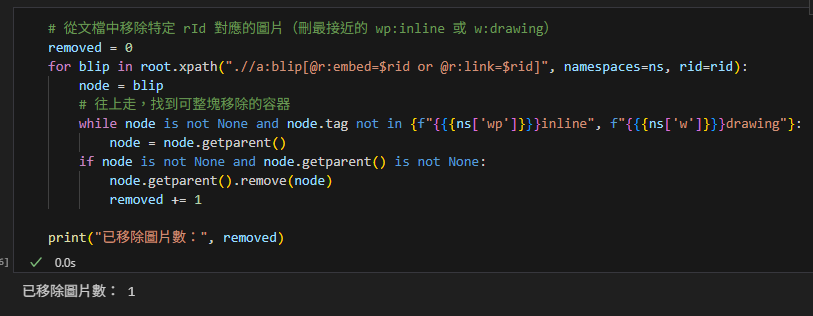
四、刪除整個命中段落
# %pip install lxml
from pathlib import Path
import zipfile
from lxml import etree
zip_path = Path(r"D:\Temp\sample.zip") # 改成你的檔
member = "word/document.xml"
rid_to_remove = "rId4" # 想刪的 rId
# 讀與解析
with zipfile.ZipFile(zip_path, "r") as zf:
xml = zf.read(member).decode("utf-8", errors="replace")
parser = etree.XMLParser(recover=True, huge_tree=True)
root = etree.fromstring(xml.encode("utf-8"), parser=parser)
ns = {
"w": "http://schemas.openxmlformats.org/wordprocessingml/2006/main",
"a": "http://schemas.openxmlformats.org/drawingml/2006/main",
"r": "http://schemas.openxmlformats.org/officeDocument/2006/relationships",
"wp": "http://schemas.openxmlformats.org/drawingml/2006/wordprocessingDrawing",
"pic": "http://schemas.openxmlformats.org/drawingml/2006/picture",
"w14": "http://schemas.microsoft.com/office/word/2010/wordml",
}
# 1) 先列出文檔內的所有 rId,確認目標值存在
all_rids = root.xpath("//a:blip/@r:embed | //a:blip/@r:link", namespaces=ns)
print("所有 rId:", sorted(set(all_rids)))
# 2) 同時嘗試兩個 XPath(等價但有時一個更穩)
xp1 = ".//w:p[.//a:blip[@r:embed=$rid or @r:link=$rid]]"
xp2 = ".//w:p[.//pic:blipFill//a:blip[@r:embed=$rid or @r:link=$rid]]"
hits1 = root.xpath(xp1, namespaces=ns, rid=rid_to_remove)
hits2 = root.xpath(xp2, namespaces=ns, rid=rid_to_remove)
print("xp1 命中段落數:", len(hits1))
print("xp2 命中段落數:", len(hits2))
# 3) 真正移除(用命中的集合做)
hits = hits1 or hits2
for p in hits:
parent = p.getparent()
if parent is not None:
parent.remove(p)
print("刪除段落數:", len(hits))
# 若需要,寫回新檔驗證
if hits:
new_xml = etree.tostring(root, encoding="unicode")
out = Path(r"D:\Temp\sample_removed.docx")
with zipfile.ZipFile(zip_path, "r") as zin, zipfile.ZipFile(out, "w", zipfile.ZIP_DEFLATED) as zout:
for item in zin.infolist():
data = zin.read(item.filename)
if item.filename == member:
data = new_xml.encode("utf-8")
zout.writestr(item, data)
print("已輸出:", out)常用語法速記
- child: a/b/c 直系子節點
- descendant: .//a 任意深度後代
- parent: ../ 回到父節點
- ancestor::w:p 往上找祖先 w:p
- predicate: w:p[w:r] 段落中含 w:r
- attribute: //@attr 任何節點上的 attr
- or/and: [@r:embed=$rid or @r:link=$rid]
在 XPath 裡:
- @ 是「屬性」選擇器
- @r:embed 指的是節點上的名為 r:embed 的屬性
- @r:link 指的是節點上的名為 r:link 的屬性
- 例如在 <a:blip r:embed=”rId4″/>,@r:embed 的值就是 “rId4”
- $ 是「變數」引用(由你的 XPath 執行端提供)
- $rid 代表一個外部傳入的變數 rid
- 在 lxml 中會這樣呼叫:
root.xpath(“//a:blip[@r:embed=$rid or @r:link=$rid]”, namespaces=ns, rid=”rId4″)
這表示把字串 “rId4” 綁定到 XPath 裡的變數 $rid
所以整句的意思是:選出所有 a:blip 節點,且該節點的屬性 r:embed 或 r:link 的值等於變數 $rid。
輸出:
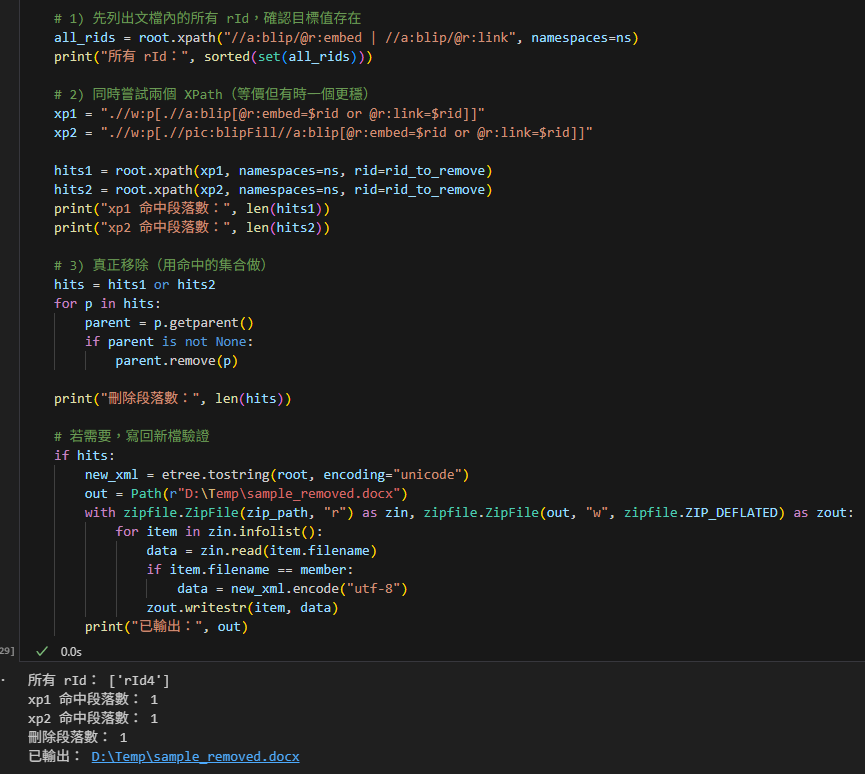
五、寫回成新的 zip 或 docx
def write_back(orig_zip: Path, out_zip: Path, new_xml_str: str):
"""把修改過的 document.xml 寫回新的壓縮包(zip/docx 皆可)。"""
with zipfile.ZipFile(orig_zip, "r") as zin, zipfile.ZipFile(out_zip, "w", zipfile.ZIP_DEFLATED) as zout:
for item in zin.infolist():
data = zin.read(item.filename)
if item.filename == "word/document.xml":
data = new_xml_str.encode("utf-8")
zout.writestr(item, data)
# 產生新檔(副檔名可用 .docx)
out_path = Path(r"D:\Temp\sample_modified.docx")
new_xml = etree.tostring(root, encoding="unicode")
write_back(zip_path, out_path, new_xml)
print("已寫出:", out_path)sample_modified.docx

六、快速驗證輸出
# 讀回剛輸出的檔案檢查是否仍存在指定 rId
def verify(zip_file: Path, rid: str):
with zipfile.ZipFile(zip_file, "r") as zf:
xml2 = zf.read("word/document.xml").decode("utf-8", errors="replace")
root_v = etree.fromstring(xml2.encode("utf-8"), parser=etree.XMLParser(recover=True, huge_tree=True))
ns_v = {
"w": "http://schemas.openxmlformats.org/wordprocessingml/2006/main",
"a": "http://schemas.openxmlformats.org/drawingml/2006/main",
"r": "http://schemas.openxmlformats.org/officeDocument/2006/relationships",
"wp": "http://schemas.openxmlformats.org/drawingml/2006/wordprocessingDrawing",
"pic":"http://schemas.openxmlformats.org/drawingml/2006/picture",
}
n = root_v.xpath("count(.//a:blip[@r:embed=$rid or @r:link=$rid])", namespaces=ns_v, rid=rid)
print(f"{zip_file.name} 中 rId={rid} 的圖片數:", int(n))
verify(out_path, "rId4")輸出:
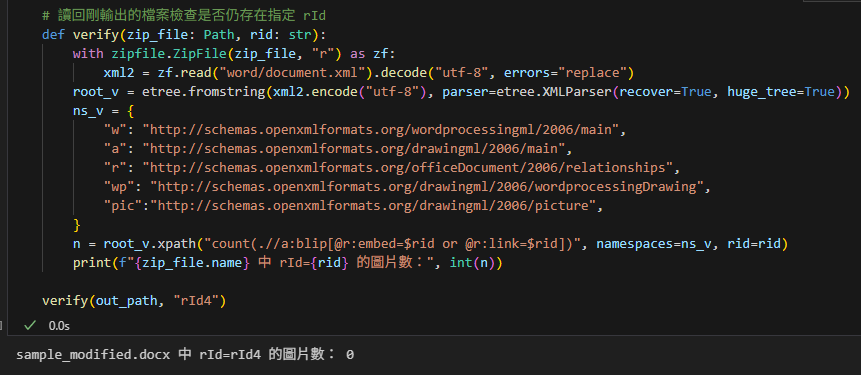
七、常見錯誤與速解
- 找不到節點:多半是命名空間 URI 沒對。前綴名稱可自訂,但 URI 必須精準一致。
- 解析錯誤:對不乾淨的 XML 使用 recover=True;對大型檔案加 huge_tree=True。
- Edge/文字編輯器看不到重點:瀏覽器只顯示,不會做 XPath;請用 lxml 驗證。
八、延伸操作範例
- 取得所有段落的 w14:paraId
para_ids = [p.get(f"{{{ns['w14']}}}paraId") for p in root.xpath(".//w:p", namespaces=ns)]
print([pid for pid in para_ids if pid])輸出:

結語
- 以 lxml.etree 操作 OOXML,核心在「正確宣告命名空間」與「用 XPath 自內而外定位」。
- 以上每段程式都能直接在 Jupyter 貼上執行,從讀取、查找,到修改與寫回完整打通。
推薦hahow線上學習python: https://igrape.net/30afN
![Python:如何使用 PyMuPDF (import fitz ) 提取 PDF 文本區塊並存儲為 DataFrame ; text: List[ Tuple[float|str|int] ] = page.get_text(“blocks”) Python:如何使用 PyMuPDF (import fitz ) 提取 PDF 文本區塊並存儲為 DataFrame ; text: List[ Tuple[float|str|int] ] = page.get_text(“blocks”)](https://i1.wp.com/savingking.com.tw/wp-content/uploads/2025/03/20250320084417_0_7783bd.png?quality=90&zoom=2&ssl=1&resize=350%2C233)









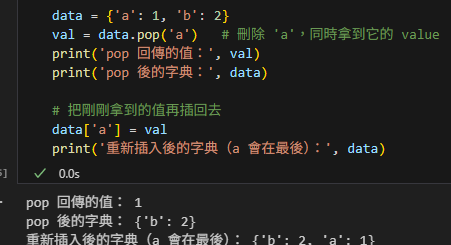
![一文搞懂Python pandas.DataFrame去重:df.drop_duplicates() 與 df[~df.duplicated()] 的等價、差異與最佳實踐 - 儲蓄保險王](https://savingking.com.tw/wp-content/uploads/2025/08/20250808202701_0_66f9bc-520x245.png)

近期留言